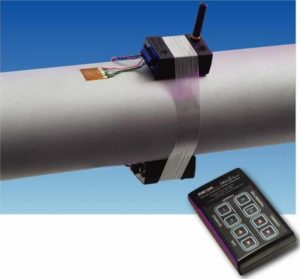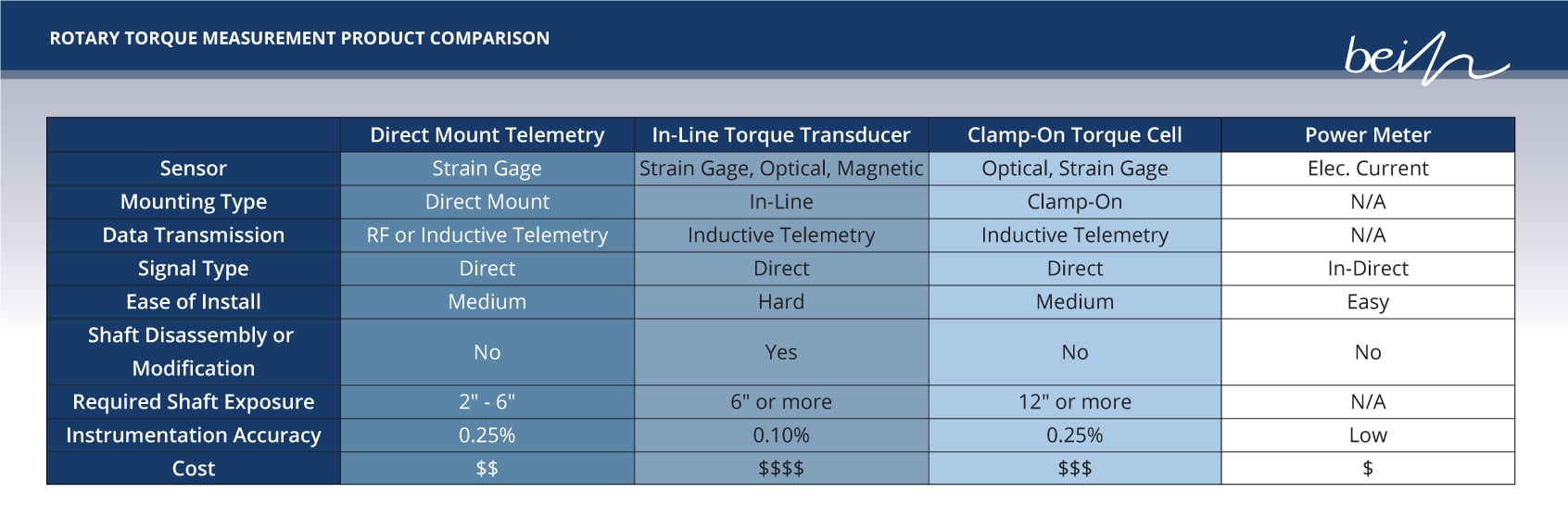When it comes to measuring torque on a rotating shaft, there are several options available depending on the application. The most common and well-known rotary torque measurement systems are in-line torque transducers. As the name suggests, these transducers are mounted “in-line” to a drive.
The main advantage of these systems is that they are factory-calibrated and can be cost-effective at smaller diameters. That being said, there are several disadvantages of in-line torque transducers worth noting, including:
-Downtime to modify driveline. This is costly, as extensive modifications must be made, and the driveline is down for the entire installation period.
-Introduces a weak point in the driveline. If specifications for the new transducer are not correct, installation of an in-line torque measurement system can introduce a weak point in the driveline that could contribute to downtime down the road.
-Unwanted vibration. If not aligned and assembled correctly, the new in-line torque transducer could introduce additional, unwanted vibration in the driveline.
-Accommodates limited torque ranges. Multiple units may be required if torque is anticipated to vary significantly, such as in test stand applications.
-Costly. Since the systems come pre-calibrated from the factory, they are often expensive compared to other rotary torque measurement systems.
Perhaps the most significant disadvantage of these systems is that they require the driveline be modified in order to accommodate the transducer. While this may work in some situations, this is not ideal for certain applications where heavy machinery is already designed and currently in-commission. This is often the case with industrial equipment or marine vessels. For applications like these, a rotary torque measurement solution that doesn’t require shaft modification is preferable.
How to Measure Torque On an Existing Shaft
Here are three of the most common methods to measure torque on an existing shaft, without modification or disassembly.
1) Electrical Power Meter
A relatively simple method to estimate torque on the output shaft of an electrical motor is to measure its electrical power input via an electrical power meter. The meter calculates the power input by measuring the current and voltage in the line driving the motor. The electrical power input is converted to an estimated torque by knowing shaft speed (usually measured via a tachometer) and the motor efficiency (usually specified by the motor manufacturer). This is considered an indirect measurement of torque since it is not the true mechanical torque but instead a relation from electrical power measurements to a theoretical torque value.
While fairly inexpensive and easy to install, this method’s accuracy is poor because the motor’s efficiency can vary substantially depending on a number of factors including speed, input voltage, output load, and temperature. This method is only valid for drivelines with an electric motor and does not respond accurately to fast changing torque conditions, making it ideal only in situations where a “gross” torque measurement is needed.
2) Clamp-on Torque Cell
A clamp-on torque cell is physically clamped onto the shaft. These systems include a pre-installed sensor (typically a strain gage or optical). The sensor measures the strain (or “twist”) on the shaft and converts that to a torque measurement value via a set of calculations that depend on the geometry and properties of the shaft.
The main advantage of these systems is that the installation does not require the application of the sensor (such as a strain gage).One of the main concerns with a clamp-on torque measurement systems is that the sensor is far-removed from the surface of the shaft, which can result in a high degree of uncertainty in the measurement. The stack-up of mechanical components in between the shaft and the sensor adds uncertainty to the measurements and exacerbates the effect of environmental variations (such as temperature) on the system. Clamp-on systems are also fairly bulky. They require a significant amount of available shaft area for proper installation, which can be problematic if you’re working in tight spaces.
3) Surface-Mount Torque Telemetry
Figure 1. Binsfeld TorqueTrak 10K torque telemetry system.
A surface-mount rotary torque measurement system relies on a strain gage sensor directly mounted to the surface of the shaft. The sensor works the same way as a clamp-on torque cell (by measuring “twist” on the shaft) and transfers the data off the shaft using telemetry, which is a wireless non-contact method of data transmission. (For a more in-depth explanation of the working concepts of a telemetry system, see How Torque Telemetry Works)
Why Not Use a Slip Ring?
Slip rings are a common method for data transfer, but they have several disadvantages compared to telemetry. Because a slip ring requires contact between the shaft and a stator, the assembly can induce noise in the signal. Contacting surfaces will eventually wear out, requiring replacement of components over time. For these reasons, telemetry data transmission is a more effective, long-term option.
Since the strain gage is mounted directly to the shaft and as close to the load as possible, surface-mount torque telemetry provides one of the most direct, accurate and cost-effective rotary torque measurement solutions available. The reduced profile of the systems enables their use in many space-constrained applications where clamp-on torque cells are not feasible.
A potential concern with surface-mount torque telemetry systems is that they require strain gage installation in the field. However, this is something that can be easily accomplished with proper training. The typical install time for a complete Binsfeld Telemetry system is 4 hours per shaft.
Comparing Rotary Torque Measurement Methods
The chart below offers a clear comparison of all the four torque measurement methods discussed in this article:
Table 1. Comparison of common rotary torque measurement systems.
Which Rotary Torque Measurement System is Best for Me?
If you’re looking for the best way to measure torque on an existing shaft, choosing between the options mentioned above will come down to what’s most important to you. If your application would benefit from the most accurate results in a small profile, and at a reasonable price, a surface-mount torque telemetry system is likely the best option. Of course, there are many other factors to consider.
For help with determining the most appropriate torque measurement method for your application, don’t hesitate to reach out to the experts at Binsfeld Engineering Inc. We would be happy to answer any questions you might have about measuring torque on an existing rotating shaft. Give us a call at 231-334-4383 or contact us online today.




